Production Value Trends: Insights and Future Directions in Manufacturing
Updated On: November 13, 2025 by Aaron Connolly
Understanding Production Value Trends

Production value shows the total worth of goods created before costs, while trends reveal how this shifts over time.
We use specific metrics to track these patterns and spot changes in manufacturing output and efficiency.
Defining Production Value
Production value equals the total worth of manufactured goods during a set period.
We figure this out before subtracting any costs or expenses.
It’s not the same as profit or net value. Production value highlights raw output, including everything made, no matter the production cost.
Key components include:
- Raw material value added
- Labour contributions
- Equipment usage value
- Technology integration benefits
Manufacturers use this metric to gauge capacity. Usually, higher production value signals better efficiency and a stronger market position.
You see production value in everyday examples too. If a factory makes 1,000 phones at £500 each, that’s £500,000 in production value for the day.
Modern factories track this hourly using digital systems. Managers get real-time data, so they can spot problems and adjust quickly.
Historical Shifts in Manufacturing Output
The manufacturing industry has changed a lot over the decades.
We shifted from manual labour to automated systems.
Major shifts include:
| Period | Key Change | Impact on Production Value |
|---|---|---|
| 1950s-1970s | Mass production lines | 300% increase in output |
| 1980s-2000s | Computer integration | 150% efficiency gains |
| 2010s-Present | AI and robotics | 200-300% productivity boost |
China leads now, handling 52% of global industrial robot installations.
This move sparked huge production value increases across Asia.
Regionalisation trends are rising too. The EU’s carbon rules are pushing 85% of manufacturers to produce closer to customers by 2026.
AI-native factories can save 30% on energy and cut defects by 99%.
Companies like Tesla and Siemens run “lights-out” operations with barely any humans on-site.
These shifts let production value climb faster, without needing bigger buildings or a massive workforce.
Smart factories squeeze more out of the same space.
Key Performance Metrics
We use several metrics to track production value trends and see how well manufacturing operations perform.
Essential metrics include:
- Output per hour: Direct measure of efficiency
- Defect rates: Lower rates mean more value kept
- Energy consumption per unit: Indicates sustainability progress
- Equipment utilisation: Shows how much capacity gets used
Modern systems track these automatically.
AI-driven predictive maintenance cuts downtime by up to 50% with 5G edge computing.
Digital twins shorten planning cycles by 30%. BMW and Renault rely on these virtual models to optimise layouts and energy use.
Workforce productivity gets measured differently now.
With 1.9 million US manufacturing jobs unfilled by 2033, companies care more about output per worker than total headcount.
Quality metrics really matter. AI-powered vision systems spot flaws quicker than people.
Tesla slashed defects and warranty costs using these systems.
Cost efficiency shows up in the numbers. Xiaomi’s AI factory churns out one smartphone per second on 11 automated lines.
That’s clear, measurable production value growth.
Global Patterns in Manufacturing Production Value
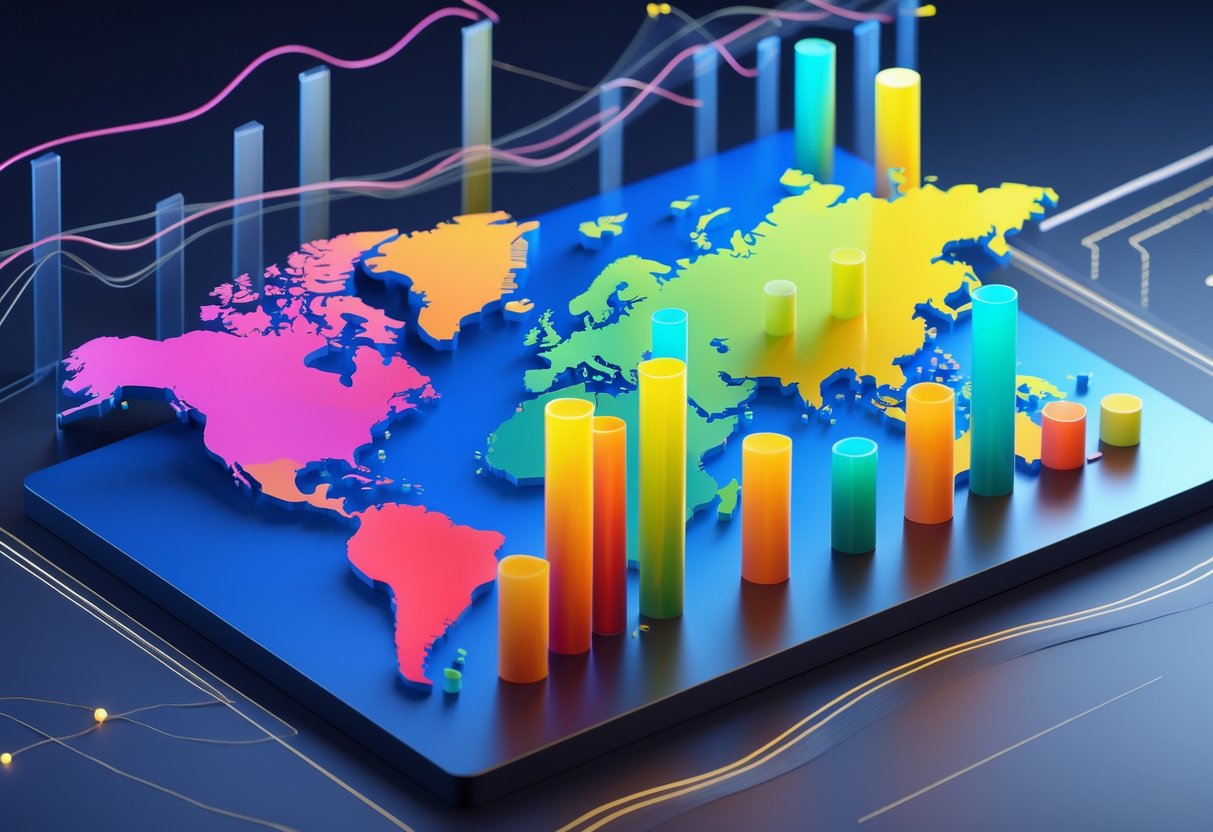
Manufacturing production value has some clear regional leaders.
China, the United States, and Germany dominate global output.
Growth rates jump around a lot between developed and emerging economies.
Geopolitical tensions keep shaking up traditional supply chains and investment flows.
Leading Countries and Regions
China holds the top spot as the world’s largest manufacturing producer by value.
The country generates around 28% of global manufacturing output, covering electronics, textiles, and machinery.
The United States comes second, focusing on high-value sectors like aerospace and pharmaceuticals.
These US industries add a lot to GDP through value-added production.
Germany leads European manufacturing.
The country excels in automotive and industrial machinery, and its manufacturing sector makes up about 20% of national GDP.
Japan and South Korea round out the top five.
Both countries specialise in technology-heavy manufacturing—think semiconductors, robotics, and precision instruments.
Other important regions include:
- India: Fast-growing textile and pharmaceutical sectors
- United Kingdom: Aerospace and chemical manufacturing
- Italy: Luxury goods and machinery
- France: Automotive and food processing
Comparative Growth Rates
Emerging economies are growing their manufacturing faster than developed ones.
Countries like Vietnam and Bangladesh see annual growth rates of 6-8%. Developed economies usually manage 2-3%.
China’s manufacturing growth has slowed to about 5% each year, as the country shifts to higher-value production.
Still, manufacturing makes up about 27% of China’s GDP.
Technology-intensive industries outperform traditional manufacturing worldwide.
These sectors bounce back better during economic disruptions.
Big data analytics helps manufacturers optimise production and make better decisions.
Manufacturing value-added as a share of GDP varies:
- Germany: 20.1%
- South Korea: 18.9%
- China: 17.8%
- Japan: 15.2%
- United States: 12.3%
Influence of Geopolitical Factors
Trade tensions between big economies keep changing global manufacturing patterns.
Companies look for alternative production locations more often now.
Regionalisation of supply chains is picking up speed.
The COVID-19 pandemic exposed weak spots in global manufacturing networks.
Many firms now put supply chain resilience ahead of cost efficiency.
This shift drives investment in domestic and regional production.
Sanctions and export controls disrupt manufacturing flows, especially in tech sectors.
Semiconductor manufacturing has turned into a strategic priority for many countries.
Climate policies also sway manufacturing location decisions.
Carbon pricing and environmental rules push companies toward cleaner production.
Some manufacturers move to countries with lighter environmental standards.
Geopolitical factors now sit near the top of the list for manufacturing investment.
Political stability, trade ties, and regulations shape where companies produce.
Many diversify their manufacturing bases to cut geopolitical risks.
Value Added: Economic Contributions and Implications

Value added is the difference between what producers pay for materials and what they get selling finished goods.
This metric captures the true economic contribution at every stage.
It directly affects national GDP calculations and acts as a key productivity indicator across industries.
Calculating Value Added in Manufacturing
Value added equals the total output value minus the cost of intermediate goods and services.
This shows the real economic contribution of each stage in manufacturing.
Take a car manufacturer: If they buy steel, electronics, and other parts for £15,000 and sell the finished vehicle for £25,000, the value added is £10,000.
Key components of value added:
- Labour costs and wages
- Capital equipment usage
- Profit margins
- Depreciation costs
Manufacturers track value added at different production stages.
Each stage adds value through processing, assembly, or finishing.
This measurement helps businesses spot which steps generate the most economic value.
They can then focus resources on high-value activities and cut costs in lower-value stages.
Impact on National and Global GDP
Value added feeds directly into GDP calculations using the production approach.
National statistics offices add up value added across all industries to measure total economic output.
GDP calculation through value added:
- Manufacturing value added
- Services value added
- Agriculture value added
- Government sector contribution
Global value chains complicate old-school GDP measurements.
Products now include value added from several countries at different stages.
A smartphone, for example, might use components from Taiwan, get assembled in China, and be designed in California.
Each country’s GDP only reflects their slice of the value added.
This fragmentation makes gross export stats less useful for measuring real economic contributions.
Countries with final assembly look more productive than component suppliers, even if the actual value creation is similar.
Relationship to Productivity Growth
Productivity grows when businesses generate more value added per hour of labour or unit of capital.
Higher productivity usually leads to better wages and economic expansion.
Value added per worker is a key productivity indicator.
When manufacturers produce more valuable goods with the same resources, productivity goes up.
Factors driving productivity growth:
- Technology improvements
- Better worker training
- More efficient processes
- Product innovation
Countries with rising manufacturing value added often grow their economies faster.
Still, productivity gains need steady investment in equipment, skills, and research.
Businesses that boost value added without ramping up costs get more competitive globally.
That edge helps them keep market share against lower-cost competitors abroad.
Trends in The United States: Production Value and Performance

The US manufacturing sector is projected to hit $2.28 trillion in value for 2025.
Industrial production is growing 1.40% year-over-year through July 2025.
Manufacturing could add $530 billion in value by maximising technology adoption and keeping more domestic content.
Recent Performance and Projections
US manufacturing value reached $2.2 trillion in 2015 and keeps growing, even with ongoing challenges.
The sector projects three possible scenarios through 2025.
If current trends hold, manufacturing GDP would rise by $350 billion in real terms.
This growth comes from higher demand and new petrochemical facilities coming online.
The “new normal” scenario keeps domestic content levels steady instead of letting them fall.
This could boost value added to $2.8 trillion by 2025.
The stretch scenario looks most promising. If the sector maximises technology adoption and export growth, manufacturing could reach $3 trillion in GDP.
That’s a $530 billion jump over current trends.
Key growth areas:
- Advanced manufacturing—aerospace and automotive
- Electronics and computers—domestic content has stabilised
- Energy-intensive production—helped by low natural gas costs
Labour shortages continue to affect the whole value chain.
From production to transportation, these challenges bring delays and higher costs through 2025.
Role of the U.S. Census Bureau in Data Collection
The US Census Bureau collects monthly and quarterly manufacturing data through economic indicator surveys.
These stats cover construction, international trade, and manufacturing activity.
The bureau’s surveys provide timely data that tracks economic performance across sectors.
Policymakers and businesses use this information to understand manufacturing trends and make decisions.
Manufacturing data collection happens through several channels.
The bureau tracks production values, employment, and trade stats to build industry reports.
Economic indicators from the Census Bureau let people measure manufacturing performance against historical trends.
The data covers everything from retail trade to wholesale operations.
Regular reporting helps spot new patterns in US manufacturing.
These insights are crucial for understanding sector health and planning investments.
Sectoral Analysis: Key U.S. Industries
Manufacturing growth is concentrated in certain industries, while others still struggle.
Pharmaceuticals, electronics, and aerospace lead output growth over the last twenty years.
Automotive manufacturing shows real potential. Foreign carmakers keep expanding US production of parts and finished vehicles.
Even small percentage gains add big value, considering the huge production base.
The aerospace industry keeps strong domestic production and enjoys global market growth.
Import competition is pretty weak here, which leaves room for expansion.
Computer and electronics industries add a lot to growth projections.
Domestic content has stabilised lately, and demand looks strong.
Energy-intensive industries benefit from low natural gas prices thanks to US shale production.
This helps keep operations cost-effective for refined petroleum, petrochemicals, and fertilisers.
Basic consumer goods offer less growth potential.
Domestic production in these sectors has already shrunk a lot due to global competition.
Manufacturing employment could rise by 2.4 million jobs in the best-case scenario.
The positive effects would ripple out, potentially creating another million jobs in supplier sectors.
Sectoral Perspectives: Key Manufacturing Industries
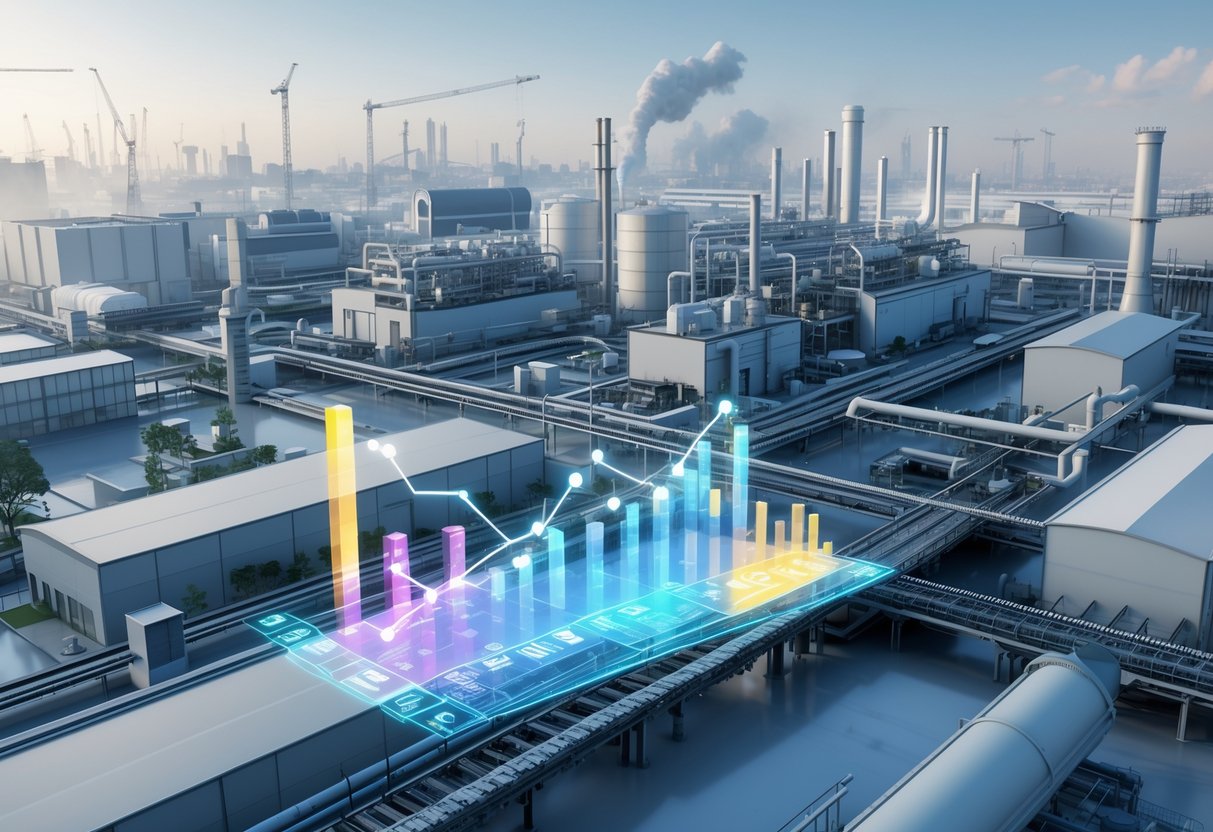
Three manufacturing sectors are driving production value changes through 2025.
Computer and electronics companies face supply chain shifts and AI integration costs.
Chemical manufacturers deal with sustainability pressures and raw material price swings.
Computer and Electronic Products
We’re watching some big changes in how computer and electronic manufacturers handle production costs. Supply chain diversification tops the list now, especially after recent disruptions made everyone realize how risky it is to depend on just one region.
AI is pushing up initial production expenses, but it cuts long-term labor costs. Companies say they’re investing 15-20% more upfront for automated assembly lines.
Key cost factors include:
- Semiconductor shortages driving component prices up 12-18%
- Green manufacturing rules adding 8-10% to facility costs
- Workforce retraining programs for AI-assisted production
Raw material costs for rare earth elements jump all over the place. Lithium prices dropped 40% this year, while cobalt stayed unpredictable.
Many manufacturers now move production closer to end markets. This “nearshoring” trend bumps up short-term setup costs, but it trims shipping expenses and lowers tariff risks.
Chemicals and Chemical Products
Chemical manufacturers feel the squeeze to keep production costs in check while meeting environmental rules. Carbon pricing impacts 60% of global chemical production sites now.
Switching to renewable energy is changing cost structures. Companies using solar and wind power pay 25% more upfront for energy infrastructure, but their ongoing expenses drop by 15%.
Petrochemical feedstock prices keep everyone guessing. When crude oil prices swing, production costs for plastics, synthetic rubber, and industrial chemicals follow.
Major cost drivers:
- Environmental compliance adding £2-4 million per facility
- Digital monitoring systems pushing IT budgets up 20-30%
- Skilled technician shortages driving wages up 8-12%
We’re seeing a shift to bio-based chemicals. Production costs run 20-40% higher than old-school methods, but government incentives help make these investments more attractive.
Pharmaceuticals
Pharmaceutical production values reflect massive R&D spending and strict compliance costs. Drug development now averages £1.2 billion per approved medicine—a hefty 18% jump from earlier estimates.
Manufacturing costs swing wildly between generic and branded drugs. Generic makers scrape by on thin margins, but specialty medicines fetch premium prices.
Critical cost elements:
- Clinical trials eating up 65% of development budgets
- Regulatory compliance needing teams of 50-100 specialists
- Cold storage and transport adding 15-25% to distribution costs
Personalized medicine brings new cost headaches. Small-batch runs for targeted therapies cost 300-500% more per unit than mass production, but they also bring in higher profit margins.
Quality control eats up the biggest chunk of operational spending. Pharmaceutical companies spend 12-15% of revenue on testing and validation to meet regulations.
Compound Annual Growth Rate in Manufacturing
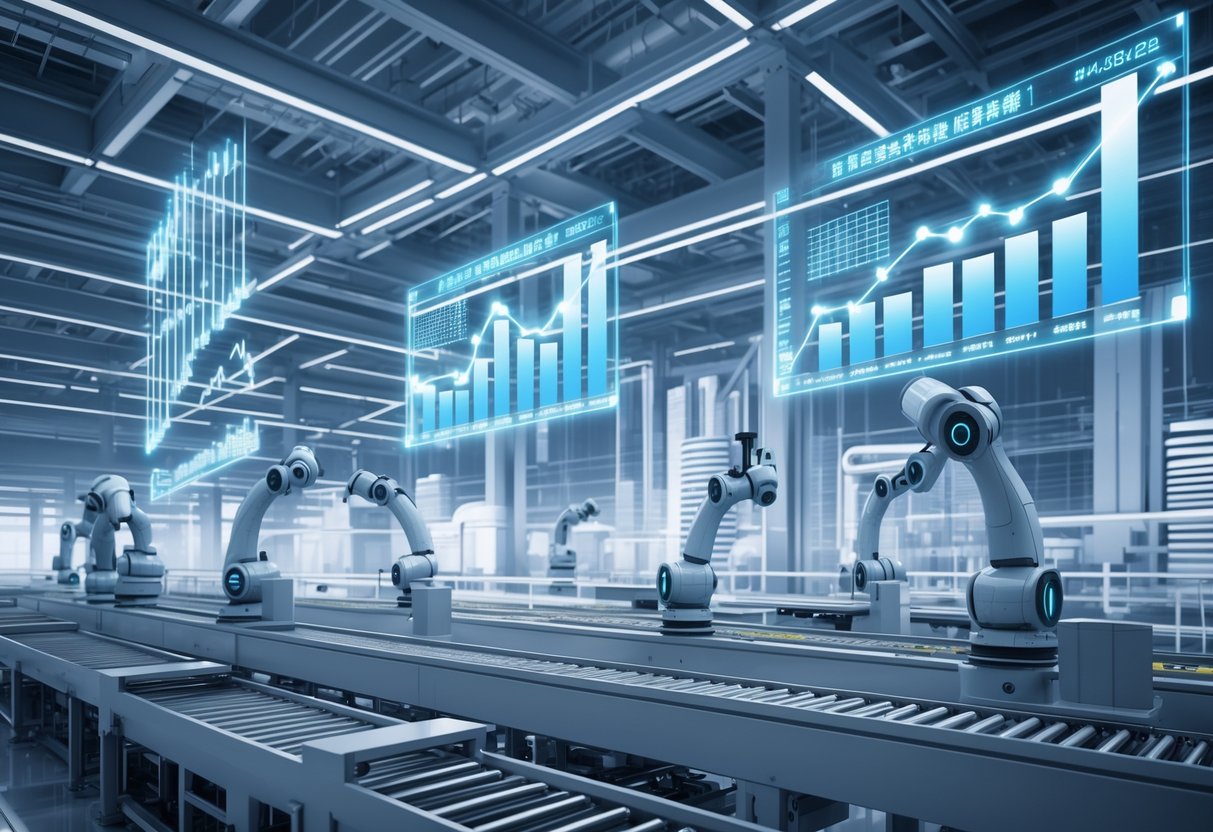
Manufacturing growth rates show clear patterns across regions and industries. Global benchmarks are reaching 4.9% through 2032.
Different sectors grow at their own pace. Forecasting methods help predict trends using historical data and market signals.
Global CAGR Benchmarks
The global manufacturing market posts a compound annual growth rate of 4.9% from 2025 to 2032. The sector is on pace to jump from £11.8 trillion in 2025 to £16.5 trillion by 2032.
Regional performance really varies:
- Asia Pacific leads with 42.7% market share
- North America holds 26.5% and grows fastest
- Europe keeps steady growth, thanks to green manufacturing
Individual countries show their own trends. The US managed 2.1% real annual growth from 1996 to 2021, which lands it below the global 50th percentile. China keeps dominating with its “Made in China 2025” push.
Key growth drivers:
- Digital transformation via Industry 4.0
- Rising demand for customized production
- Automation and AI integration
CAGR by Sector
Manufacturing sectors each have their own growth story, shaped by tech adoption and market demand. The automotive sector leads with 21.4% market share in 2025, powered by electric vehicles and advanced manufacturing.
Technology-based segments look different:
| Segment | Market Share | Growth Characteristics |
|---|---|---|
| Traditional Manufacturing | 42.3% | Stable, tried-and-true methods |
| Smart Manufacturing | Growing rapidly | Industry 4.0 adoption |
| Electronics & Semiconductors | 0.5% (5-year CAGR) | Slower but steady |
Computer and electronic manufacturing equipment is growing at 0.5% CAGR over five years. Manufacturing structures move faster at 4.5%, showing strong infrastructure investment.
Pharmaceutical and food & beverage sectors keep steady growth with more automation. Aerospace & defense gets a boost from precision manufacturing.
Long-Term Forecasting Techniques
Manufacturing forecasting pulls from a bunch of data sources to predict compound annual growth rates. Analysts dig into historical data over full business cycles to spot patterns.
Primary forecasting methods:
- Historical trend analysis using 15+ years of data
- Cross-sector comparison across 35+ industries
- Geographic analysis covering 44 countries
- Real-time production monitoring
To calculate CAGR, analysts divide the end value by the beginning value, raise it to the power of 1/number of years, and subtract 1. This gives an annualized average over time.
Forecasting challenges:
- Supply chain disruptions shake up predictability
- Trade tensions shift growth patterns
- Tech adoption changes sector dynamics
- Environmental rules impact traditional methods
Analysts update forecasts every quarter using production data from national statistical offices and central banks. This keeps things as accurate as possible in a fast-changing industry.
European Union Production Value Trends

The EU’s production value hit €5.992 trillion in 2023. Industrial output shows mixed results across member states.
Ireland and Poland lead growth at 5.6% and 4.9%. Southern nations still face plenty of challenges.
Recent Declines and Recoveries
The EU saw a lot of volatility in production values lately. Between 2021 and 2024, production dropped by 0.4% each year, following the pandemic’s sharp 7.4% fall in 2020.
Early 2025 brought some hope. May posted a 1.5% month-on-month increase in industrial production.
Year-on-year numbers looked even better, with a 3.4% rise across the EU. June 2025 kept up the pace with 0.5% growth compared to June 2024.
The eurozone did a bit better, showing 0.2% year-on-year growth. Manufacturing sectors powered most of this rebound.
Fabricated metal products stood out, helped by new construction projects and infrastructure spending in member states.
Country Contributions to EU Output
Production value contributions swing a lot across the EU. Ireland leads with 5.6% average growth, with Poland right behind at 4.9% from 2000-2024.
These top performers look very different from struggling southern economies. Italy shrank by 1.1% a year, and Portugal by 0.9%.
Germany still brings the most in absolute terms, even with modest growth. France keeps output steady, although it’s not matching its old highs.
Eastern European nations now drive much of the EU’s production gains. Their lower labor costs and modern plants attract investment from traditional western centers.
Sectoral Shifts Within Europe
Manufacturing sectors aren’t all moving at the same speed across the EU. Traditional heavy industry faces tough competition and stricter environmental rules.
Fabricated metal products are growing fast. These industries benefit from renewable energy projects and the shift to electric vehicles in the auto sector.
High-tech manufacturing is picking up, especially in Ireland and the Netherlands. Pharmaceuticals and advanced electronics now play a bigger role in production values.
The mining industry index dropped by more than 50 points between January 2000 and spring 2005. The EU is clearly moving away from extractive industries and into higher-value manufacturing.
Service-related manufacturing is growing quicker than traditional production. That includes custom fabrication, repair services, and specialized component manufacturing for niche markets.
Drivers of Change: Technological Advancement and Automation
Technology and automation keep changing how manufacturers make things and run their operations. Digital tools are making factories smarter.
Companies are moving production closer to home and increasing worker output.
Digitalisation in Manufacturing
The Industrial Internet of Things (IIoT) is now standard in modern manufacturing. Machines and devices connect to gather real-time data and make operations smarter.
Edge computing processes data right at the source for instant analysis. Manufacturers without big IT teams benefit from this. The tech delivers fast responses and catches data as it happens.
Cloud computing is great for smaller companies that want to avoid heavy investment in on-site systems. It cuts costs and makes data easier to access anywhere.
A lot of manufacturers now use edge and cloud computing together. Edge handles real-time monitoring, while cloud manages storage and analysis.
Digital twins create virtual copies of equipment. Manufacturers can test changes and catch problems before they hit real production.
Vision systems and smart interfaces let workers interact with machines more easily. These tools cut down on errors and speed up training for new hires.
Reshoring and Supply Chain Optimisation
Supply chain disruptions have pushed manufacturers to bring production closer to home. Advanced automation helps by shrinking labor cost differences between countries.
Flexible manufacturing systems switch quickly to new products. Robots can change tasks without major retooling. Manufacturers can respond faster to local market demand.
Smart factories use data to fine-tune inventory. They track materials in real time and predict when to reorder. This cuts waste and prevents shortages.
| Benefit | Impact |
|---|---|
| Shorter lead times | Products reach customers 2-4 weeks faster |
| Lower transport costs | Logistics expenses drop by 15-25% |
| Better quality control | Fewer defects thanks to closer oversight |
Regional hubs are replacing single global factories. This spreads out risk and keeps things running if one site goes down.
Automation and Labour Productivity
Automation tech is giving productivity a real boost in manufacturing. Workers now focus on higher-value jobs, while machines handle the boring, repetitive stuff.
Collaborative robots work safely alongside people. They help with assembly, packaging, and quality checks. Output goes up without replacing entire teams.
Predictive maintenance uses sensors to watch equipment health. This stops breakdowns and stretches out machine life. Manufacturers report 20-30% fewer unplanned shutdowns.
Workforce upskilling is becoming a must as tech advances. Companies pay for training so workers can run new systems. This leads to better jobs and keeps people around longer.
AI-powered quality control spots defects faster than people can. Vision systems check thousands of products an hour with steady accuracy.
The end result? Higher output per worker and better products. Manufacturers stay competitive globally while keeping local operations alive.
Challenges and Risks Shaping Production Value
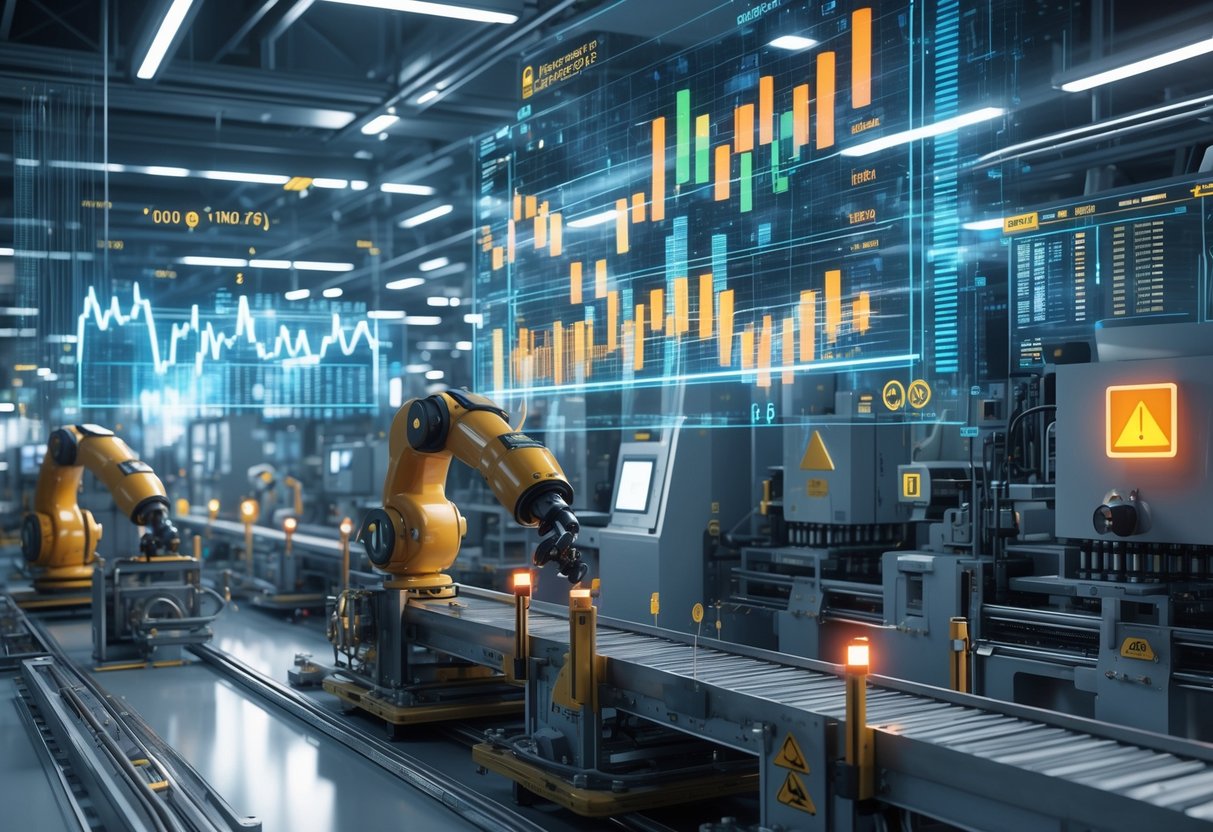
Manufacturers face growing pressures that hit their ability to create value efficiently. Higher energy costs, workforce shortages, and supply chain headaches are changing how we think about production economics.
Energy and Resource Costs
Energy prices have become a real headache for manufacturers. Many factories now spend 15-20% of operating budgets just on electricity and fuel.
Rising electricity prices hit energy-heavy industries the hardest. Steelmakers, chemical plants, and aluminum smelters feel the pinch. Some report energy costs have doubled since 2022.
Resource scarcity adds another layer of stress. Materials like lithium, rare earth metals, and semiconductors are tough to get. These shortages push up raw material costs and force companies to look for alternatives.
Price swings make planning a nightmare. Oil prices can jump or drop 30-40% in a matter of months, messing with transportation and petrochemical costs. Companies end up building bigger financial reserves just to cope.
A lot of manufacturers are turning to renewable energy. Solar panels and wind turbines help cut long-term costs, but the upfront investment is steep.
Labour Markets and Skills Shortages
Manufacturing struggles with a shrinking workforce. Baby boomers retire faster than young people sign up for these jobs.
Skills gaps hurt production quality and efficiency. Modern factories need workers who know both traditional manufacturing and digital tech. Finding people with both skill sets is tough.
Wages keep climbing as companies fight for talent. Manufacturing pay has gone up 4-5% a year lately. This raises costs but does help attract new workers.
Training programs eat up time and money. Companies spend months getting new hires up to speed on the basics. Advanced manufacturing needs even longer training.
Automation helps, but it brings new challenges. Workers must learn to run robotic systems and manage digital processes. This shift means constant learning and adaptation.
Supply Chain Vulnerabilities
Global supply chains deal with all sorts of disruptions. Port strikes, bad weather, and geopolitical tensions keep everyone on their toes.
Single-source dependencies put manufacturers in a tough spot. If just one supplier drops the ball, whole production lines can grind to a halt. Companies are hunting for more suppliers for their key components now.
Transportation costs jump around a lot. Container shipping rates can suddenly triple when things go wrong. For many products, air freight just gets too pricey.
Inventory management is a constant balancing act. Holding extra stock helps avoid shortages, but it ties up cash. Just-in-time delivery saves money but leaves companies more exposed.
Regional conflicts disrupt important supply routes. The Suez Canal, Panama Canal, and other major shipping lanes get blocked from time to time. These events ripple through manufacturing networks everywhere.
A lot of companies are now putting supply chain visibility at the top of their list. Real-time tracking systems help spot issues early. That means they can react faster when trouble starts.
Sector Spotlights: High-Growth and High-Value Segments

Manufacturing sectors keep showing strong growth, especially in fabricated metal products where new tech boosts efficiency. Medical devices are expanding thanks to innovation and an aging population. Meanwhile, consumer goods manufacturers are scrambling to keep up with shifting buyer preferences and sustainability demands.
Fabricated Metal Products
We’re seeing remarkable growth in fabricated metal products as more manufacturers put money into automation and precision tech. This sector is riding high on demand from construction, automotive, and aerospace.
Key growth drivers include:
- Advanced manufacturing techniques that cut waste by 15-20%
- Smart factory integration that speeds up production
- More sustainable metal processing
Companies spend about 30% of their budgets on tech investments. Their focus is on AI-powered quality control and robotics for tricky fabrication work.
Production value increases come mostly from high-margin custom work, not basic commodity products. Manufacturers making precision parts for renewable energy systems are reporting the best growth.
Investment priorities are all about equipment upgrades and workforce training. Skills gaps in welding and CNC work open doors for companies that offer good pay and technical training programs.
Medical Devices
Medical device manufacturing keeps growing at a steady double-digit pace, with biotech segments hitting 12-15% compound annual growth rates. Aging populations and personalized medicine fuel this trend.
Innovation areas with the highest returns:
- Genetic research tools
- Remote monitoring devices
- Minimally invasive surgical equipment
We’re seeing a lot of money go into regulatory compliance systems as global standards get tougher. Companies that succeed here move quickly but don’t skip thorough testing.
Manufacturing trends are shifting toward smaller, more flexible facilities. This lets companies roll out new products faster and get to market sooner.
Quality standards demand big upfront investments, but they pay off. Top manufacturers say 40-60% of development costs go to regulatory approval.
Consumer Goods
Consumer goods manufacturers are dealing with fast-changing market dynamics as sustainability and digital tools reshape production. Circular economy models are influencing product design right from the start.
Major changes we’re seeing:
- Buy-back and repair programs
- Sustainable packaging rules
- Direct-to-consumer sales channels
Technology spending leans heavily toward data platforms and supply chain tracking. Manufacturers are watching consumer preferences in real time so they can adjust production on the fly.
Brand differentiation now depends more on environmental credentials than old-school marketing. Companies with strong ESG strategies see better customer loyalty and can charge higher prices.
Production flexibility is a must as consumer habits shift quickly. Manufacturers with modular systems adapt better to demand swings than those with fixed lines.
Outlook for Production Value Trends to 2030
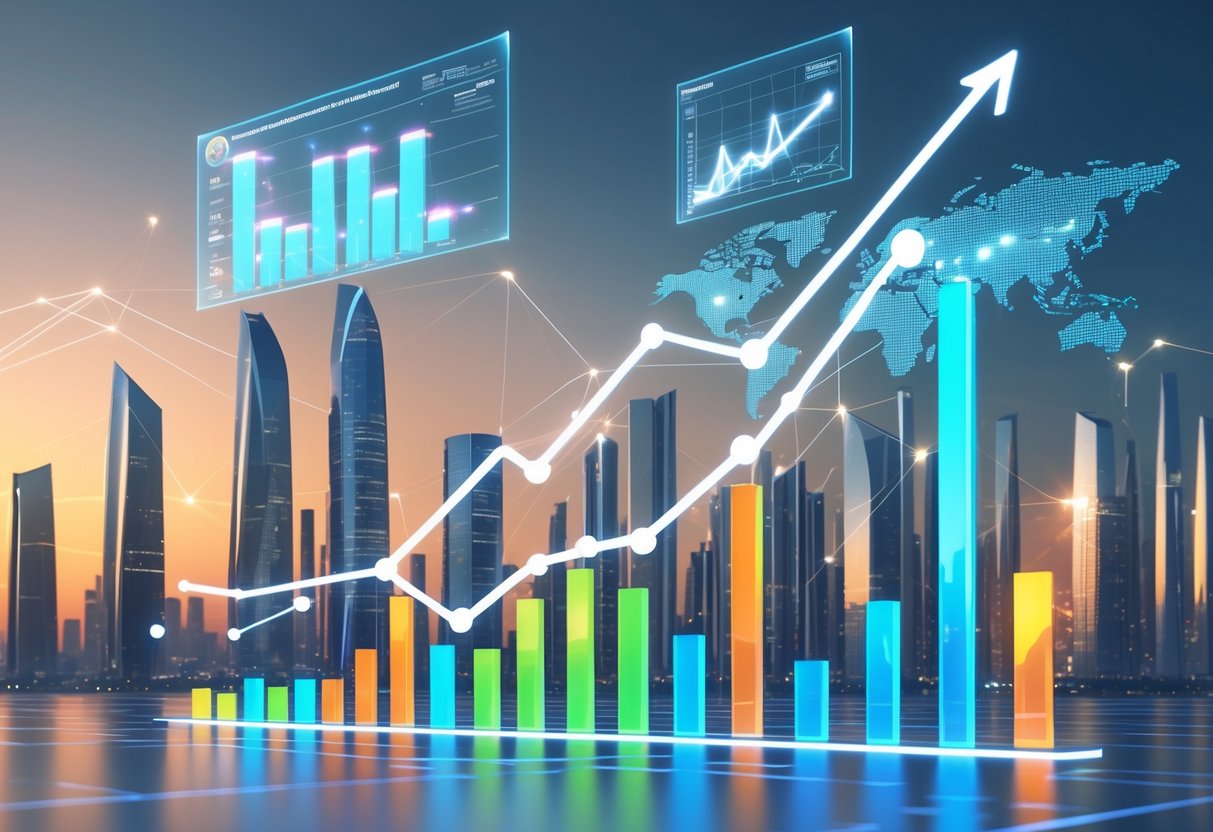
Manufacturing output looks set for huge changes over the next decade. AI-powered automation could triple productivity, while carbon pricing policies shake up global supply chains. Regional manufacturing hubs are popping up as companies juggle cost and sustainability.
Forecasts for Major Regions
Asia-Pacific Manufacturing Leadership
China keeps leading the way on industrial robots, with 52% of global installations. AI-powered factories like Xiaomi’s Changping facility—churning out 10 million devices a year with full automation—are setting a new standard.
Japan sticks with precision manufacturing, especially through companies like FANUC. South Korea is bracing for steel export headaches as CBAM tariffs could hit $72-83 per tonne by 2030.
European Carbon Compliance Drive
The EU’s Carbon Border Adjustment Mechanism (CBAM) will soon cover 99% of CO2 emissions from key imports. This move is cutting Chinese steel shipments by 25% and adding EUR 1.1 billion in costs for Russian steel.
European manufacturers like BMW and Siemens are pouring money into digital twins and modular production cells. These systems can slash material waste by up to 90% and still hit quality marks of 99.99%.
North American Reshoring Acceleration
The US could have 1.9 million unfilled manufacturing jobs by 2033, risking $1 trillion in lost productivity. Still, 85% of manufacturers plan to bring production closer to home by 2026.
Companies are boosting their workforce with tech. Tesla’s Shanghai plant runs at 95% automation, and BMW is using AI-powered cobots to help workers on the line.
Emerging Innovations
Autonomous Production Systems
AI-powered factories are delivering 2-3x productivity boosts and cutting defects by 99%. Philips runs facilities with 128 robots and just 9 human inspectors, pumping out 20 million razor blades a year.
These setups use real-time computer vision and edge computing to tweak production on the fly. Energy use drops by 15-20% compared to old-school factories.
Additive Manufacturing Scale-Up
Additive manufacturing could hit $90 billion by 2032. Boeing, Adidas, and General Atomics are all using multi-material 3D printing and AI quality checks for flight parts and high-performance goods.
Microfactory Networks
Urban microfactories are slashing freight emissions and cutting lead times. Companies like Olympian Motors are shifting to distributed production models as shipping costs keep climbing.
Modular, self-reconfiguring production cells switch up fast to handle different products. This flexibility is fueling the move toward hyper-local manufacturing.
Equipment-as-a-Service Models
The EaaS market could reach $27.8 billion by 2030. ABB’s robotics-as-a-service and similar pay-per-use models let manufacturers tap into advanced automation without huge upfront costs.
This lets smaller manufacturers compete with the big guys by accessing top-tier equipment through service deals.
Policy and Regulatory Implications
Carbon Pricing Expansion
Carbon pricing now covers 28% of global emissions, up 4 points recently. The EU’s CBAM will soon stretch to over 50% of emissions under the EU Emissions Trading System by 2030.
Steel imports get hit hardest, with tariffs possibly reaching $210-243 per tonne by 2034. Manufacturers are investing 2.5-4x more in digitalizing and relocating their facilities.
Supply Chain Compliance Requirements
The EU’s Corporate Sustainability Due Diligence Directive means companies must map risks and audit emissions from end to end. Over 6,000 firms need to comply by 2030, and Digital Product Passports will be mandatory by 2029.
Volvo, BMW, and Schneider Electric already use passport systems to track emissions through a product’s life. This transparency is a big advantage, as 74% of consumers are willing to pay more for sustainable goods.
Trade Policy Restructuring
About 89% of CEOs see geopolitical tensions and trade policies as serious risks. Foreign direct investment is shifting away from low-cost countries like Brazil and India to connector markets such as Mexico and Bangladesh.
Two-thirds of manufacturers are switching to “power-of-two” sourcing, spreading supply across two regions instead of relying on global networks. This keeps costs down and reduces disruption risk.
Frequently Asked Questions

Production value trends are moving fast, with AI-powered factories tripling output and 85% of manufacturers planning regional supply chains by 2026. These changes reflect bigger shifts in tech, workforce challenges, and sustainability demands across manufacturing.
What are the emerging trends in the manufacturing industry we should look out for?
AI-powered factories are really changing the game. These fully automated plants run around the clock with barely any human help, cutting defects by 99% and saving 30% on energy.
Regional supply chains are picking up speed. By 2026, 85% of manufacturers want to produce and sell in the same region to dodge carbon tariffs and political risks.
Workforce augmentation is another big one. Cobots and AI copilots are helping fill the 1.9 million manufacturing jobs the US could be missing by 2030. Companies like Hyundai are rolling out exoskeletons and AR training.
Additive manufacturing is scaling up, with the market expected to hit £72 billion by 2032. Boeing and Adidas are using multi-material 3D printing for flight parts and high-performance shoes.
How is the industrial production index expected to change in the forthcoming years?
Industrial production indices are shifting as manufacturing gets smarter and more automated. Countries investing in AI-powered factories and digital infrastructure should see stronger growth.
China leads with 52% of global industrial robot installations, so it’s set for continued gains. Japan sticks to precision manufacturing with companies like FANUC.
European manufacturers are doubling down on digital twins and sustainability. The EU’s Carbon Border Adjustment Mechanism will shake up production indices as companies adapt to new carbon pricing.
Regional differences will stand out more as supply chains localize. Countries with stable trade policies and skilled workforces will pull in more investment.
What factors are influencing the future of production in the manufacturing sector?
Carbon pricing is a big deal now. The EU’s CBAM covers 28% of global emissions and will reach over 50% by 2030, so low-carbon production is becoming a must.
Geopolitical tensions are top of mind for 89% of manufacturing CEOs, pushing the shift from low-cost hubs to more stable markets.
Critical material shortages are a real headache. The US depends on imports for 10 key minerals, while China controls 17 rare earth elements.
Workforce shortages are driving up automation. With 65% of manufacturers reporting skill gaps, companies are pouring money into AI and robotics.
In which ways is technological advancement shaping global industrial production?
AI and machine learning enable predictive maintenance that halves downtime. Real-time analytics powered by 5G edge computing let companies tweak production instantly.
Digital twins are cutting planning cycles by 30% and allowing real-time factory simulations. BMW and Renault use platforms like NVIDIA Omniverse to optimize energy use and layouts.
Autonomous mobile robots and humanoid robots are stepping in to fill labor gaps. Global demand for humanoid units could top 1.1 million by 2035.
Industrial IoT is tying production networks together. Schneider Electric’s factories have cut energy use by 25% with digital tools.
What does recent industrial production data suggest about the health of the manufacturing industry?
Recent data shows manufacturing is holding up, even with global challenges. Companies investing in automation and AI are seeing productivity double or triple compared to traditional plants.
The global manufacturing market is valued at £11.9 trillion for 2025 and could hit £16.6 trillion by 2032. This growth comes from ongoing digital transformation.
Skills shortages are still a problem, with 74% of employers struggling to find qualified people. Still, 48% of manufacturers plan to expand their workforce by adopting smart manufacturing.
Supply chain disruptions jumped 38% year-over-year in 2024, but manufacturers with regional networks are bouncing back faster.
How are different countries’ industrial production indices expected to evolve by the end of the decade?
China will probably hang onto its production lead. The country keeps pouring money into automation, but honestly, growth might slow down a bit as labor costs climb and global tensions heat up.
The US deals with some real workforce headaches, yet it dives headfirst into advanced manufacturing tech. If companies keep betting on nearshoring and automation, production numbers could jump quite a bit.
European countries lean into sustainable manufacturing and stick to tough compliance rules. Investors seem to like the UK and Germany lately—they feel like steady connector markets.
Japan keeps nailing precision manufacturing in Asia. Meanwhile, places like Mexico and Bangladesh are starting to stand out as connector hubs for regional production networks.

